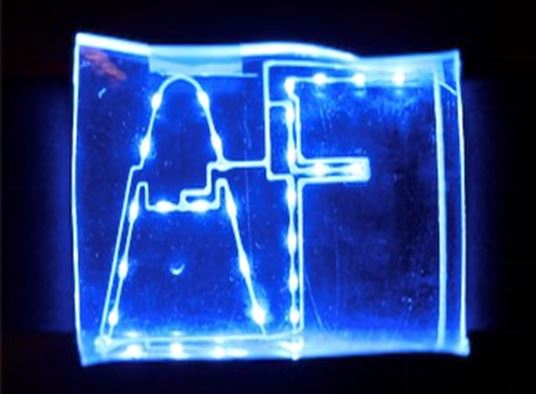A hybrid 3D printing method for flexible electronics
It is often said that ‘two heads are better than one;’ for the Air Force, leveraging the expertise and insights of academia has led to advances in materials development and processing destined to be a game changer for the future fight. A collaboration between scientists at the Air Force Research Laboratory and Harvard University’s Wyss Institute for Biologically Inspired Engineering has resulted in a new method for digital design and printing of stretchable, flexible electronics.
The process, called Hybrid 3D printing, uses additive manufacturing to integrate soft, conductive inks with a material substrate to create stretchable, wearable electronic devices.
“This is the first time a 3D printer has been shown, in a single process, to print stretchable sensors with integrated microelectronic components,” said Dr. Dan Berrigan, a research scientist at the AFRL Materials and Manufacturing Directorate.
“Starting from nothing, the printer builds an entire stretchable circuit that blends the mechanical durability of printed components with the robust performance of off-the-shelf electronics.”
In this demonstration, a 3D printer was used to print conductive traces of flexible, silver-infused thermoplastic polyurethane. A pick-and-place method was then used to set microcontroller chips and LED lights into the flexible substrate, augmented by an empty printer nozzle and vacuum system to create the hybrid system.
When tested, the additively manufactured, hybrid-electronic devices were able to maintain function even after being stretched by more than 30% from original size.
“This has a lot of potential for Air Force applications, particularly in the areas of rapid prototyping, wearable electronics, sensors and human performance monitoring,” said Berrigan. “Skin-worn electronics have the potential to provide feedback on movement, body temperature, fatigue, hydration and other metrics crucial to understanding Airmen performance. However, while skin is inherently soft and stretchable, electronics and sensors are not.”
“Additive manufacturing lets us custom design complex form factors that can enable electronics to be integrated into unique places,” he continued. “Repackaging high-performance electronics to be stretchable and tailored to an individual often begins with rethinking the materials and processes used to manufacture these devices.”
As part of the study, the Harvard team printed sensors and placed microelectronics onto a spandex sleeve able to respond to the movement of the wearer’s arm. They also created a pressure sensor for shoes, able to sense and monitor gait.
AFRL researchers also tested the processes in the lab and are investigating the possibility of using the same methodologies to build antennas and sensors into structures.
“The use of 3D printing allows us to fundamentally rethink how we package and design electronics for Air Force needs,” said Berrigan. “We are no longer limited to in-plane electronics manufacturing, which opens up opportunities to merge structure and electronic function.”
One challenge the team is focusing on for future work will address the powering of the devices, which would require a stretchable battery or other printed power source to be integrated into the manufacturing process.
“Integrating a robust, flexible and high energy-density battery has been difficult because what makes a good battery does not necessarily make for a good, soft-material system,” said Dr. Michael Durstock, AFRL Soft Matter Materials Branch chief and a co-author of the study. Though the materials and methodology are still in the early stages of development, the potential future application space is enormous.
“We have both broadened the palette of printable electronic materials and expanded our programmable, multi-material printing platform,” said Dr. Jennifer Lewis, a research collaborator from the Harvard Wyss Institute.
“This is an important first step toward making customisable, wearable electronics that are lower-cost and mechanically robust.” The paper is the first published collaborative effort between researchers at AFRL and Harvard in this area.
“This effort highlights our relationship with academia,” said Berrigan. “We can learn from their expertise and insight and make the connections to enable the technology and applications for Airmen as quickly as we can. Prof. Lewis’ team has been invaluable to us, and we are looking forward to future collaborations.”












